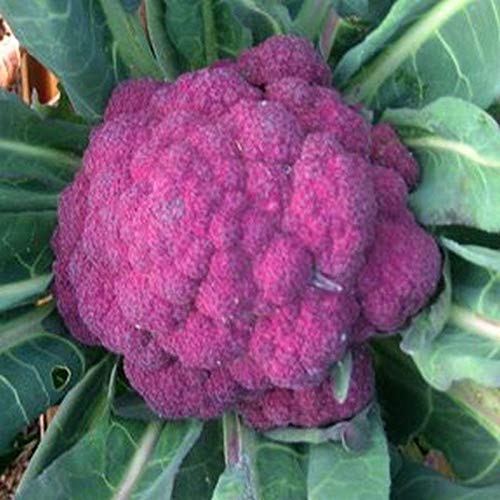Description
Violetta Italia Cauliflower
50 Seeds per pack
Days to Maturity: 80–100 Days
Sun Requirements: Full sun (6–8 hours); tolerates partial shade in hot climates to prevent bolting.
Botanical Name: Brassica oleracea var. botrytis
Originally developed in Sicily more than a century ago, Violetta Italia remains a treasured heirloom in gardens and kitchens alike. This striking variety produces medium to large heads, typically 6–8″ in diameter, with a rich purple color that transforms to bright green when cooked. Unlike most cauliflower types, Violetta Italia can form flavorful side shoots after the main head is harvested, extending your harvest and increasing overall yield.
Plants grow 24–30″ tall and 12–24″ wide, requiring ample spacing—about 20″ between plants—to allow for their generous growth habit. Best grown as a spring transplant or summer direct sowing for fall harvests, this variety thrives in many gardens!
The flavor is mild, nutty, and slightly sweet—perfect for roasting whole, slicing into vibrant risottos, or adding eye-catching flair to veggie platters. Its rich anthocyanin content not only delivers antioxidant benefits, but also gives the curds their deep purple color, which can be partially preserved by quick cooking. Rich in vitamins C and K, Violetta Italia is as nourishing as it is beautiful—a showstopper in both garden and kitchen!
Planting Instructions for Violetta Italia Cauliflower Seeds
When to Plant:
Start Violetta Italia cauliflower seeds indoors 4–6 weeks before your last expected spring frost. For a fall crop, sow seeds indoors 10–14 weeks before your first expected fall frost. Transplants should be 4–6 weeks old, with 4–6 true leaves, and fully hardened off before planting outdoors. Violetta Italia cauliflower can also be sown directly outdoors, but this is best done in late summer for a fall harvest, as spring direct-sowing often results in bolting due to uneven temperatures.
Direct sowing in spring is not recommended unless you have a very stable, mild climate. For continuous harvests, sow in succession every 2–3 weeks over a 6-week period. Avoid sowing during periods of high heat, as Violetta Italia cauliflower is sensitive to temperature extremes.
Where to Plant:
Choose a site with full sun exposure—at least 6 hours daily. In hot climates, providing light afternoon shade using shade cloth, row covers, or taller companion plants can help prevent heat stress and bolting. Plant in rich, well-drained soil. Violetta Italia cauliflower requires a slightly alkaline pH of 6.5 to 7.5 to deter clubroot and promote healthy growth. If needed, lime the soil in the fall prior to spring planting.
Amend the bed with 2–3 inches of compost or well-rotted manure and work it into the top 6–8 inches of soil. For heavy clay soils, improve drainage by adding coarse sand or compost. Practice strict crop rotation: do not plant Violetta Italia cauliflower where any brassica (cabbage, broccoli, kale, etc.) has grown in the past 3 years.
How to Plant:
Sow seeds ¼–½ inch deep in seed trays or pots filled with sterile, peat-free seed-starting mix. Maintain soil temperature at 70–80°F for optimal germination. Use a heat mat if needed. Seeds usually sprout in 8–14 days. Once seedlings develop their first set of true leaves, thin to one plant per cell or pot. Harden off seedlings over 7–10 days before transplanting outdoors. Space transplants 18–24 inches apart in rows spaced 24–30 inches apart. Plant slightly deeper than they were growing in their containers, firm the soil around the roots, and water well.
Growing Tips:
Violetta Italia cauliflower is a heavy feeder and benefits from a steady supply of moisture and nutrients. Keep the soil consistently moist, watering deeply once or twice per week depending on rainfall. Use mulch—such as shredded leaves, grass clippings, straw, or compost—to retain moisture, suppress weeds, and moderate soil temperature. Avoid overhead watering to reduce the risk of disease. Apply a nitrogen-rich organic fertilizer (e.g., fish emulsion) every 2–3 weeks during early growth, and again once heads begin to form. Too much nitrogen, however, may cause hollow stems.
Use floating row covers from the moment of planting to protect from cabbage worms, root maggots, aphids, and flea beetles. If you notice the white cabbage butterfly in your garden, take immediate action to check for larvae. For fall crops planted in warm weather, provide partial shade with cloth or netting to prevent bolting.
Blanching:
Violetta Italia cauliflower does not require blanching to protect the head color—its deep purple pigment comes from anthocyanins and is not damaged by sunlight. However, color can fade when overcooked, so steam or sauté briefly to retain its brilliant hue. Tying leaves is not necessary and may trap moisture unnecessarily.
Harvesting:
Harvest when the heads are firm, compact, and about 6–8 inches wide (or the expected size for your region and growing conditions). Use a sharp knife to cut the stem just below the head, leaving several outer leaves attached to protect it. Don’t wait too long—once the head loosens or begins to separate, it will lose texture and flavor. If buds start to elongate or open, harvest immediately.
Violetta Italia cauliflower can produce edible side shoots after the main head is harvested. Leave the plant in place and continue watering and feeding to encourage regrowth. If you’re collecting seed instead, allow the plant to overwinter. Violetta Italia cauliflower is a biennial, and seeds only form in the second year of growth. Do not harvest the head if you intend to collect seed—let it mature and flower the following season.
Saving Seeds:
Violetta Italia cauliflower is a biennial and will not produce seed until its second year. In cold climates, plants must be overwintered indoors or in a protected cold frame. Allow at least one healthy, disease-free plant to overwinter. If successfully overwintered without premature bolting, it will send up a tall flower stalk with yellow blooms in spring. After pollination, seed pods (siliques) will form and mature over the summer. Wait for the pods to dry and turn brown on the plant. Then pull the entire plant and hang it upside-down in a well-ventilated, dry area.
Once the pods are fully dry and brittle, thresh them by gently crushing or twisting over a clean, light-colored surface. Winnow out the chaff and collect the seeds. Label and store in a glass jar or seed-saving envelopes. Violetta Italia cauliflower seeds can remain viable for 4–5 years if stored in a cool, dark, dry location. To prevent cross-pollination, isolate Violetta Italia cauliflower from other brassicas—broccoli, cabbage, and Brussels sprouts—by ½ mile or more if seed purity is desired.
Storage & Preservation:
Fresh:
To store fresh Violetta Italia cauliflower, keep the head unwashed and place it in a perforated plastic bag to allow airflow. Position the head stem-side up in your refrigerator’s crisper drawer to prevent moisture from collecting on the florets. Keep at a cool 32–40°F. Stored this way, Violetta Italia cauliflower will stay crisp and fresh for 5–7 days.
Cut:
Break or cut the head into florets and spread them out on a paper towel to remove any surface moisture. Once dry, transfer the florets to an airtight container or resealable bag. Store in the refrigerator and use within 3–5 days for best flavor and texture.
Freezing:
Begin by rinsing and cutting Violetta Italia cauliflower into uniform florets. Bring a large pot of water to a rolling boil, add a tablespoon of salt if desired, and blanch the florets for 3 minutes. Immediately transfer them into a bowl of ice water to stop the cooking. After cooling for a few minutes, drain and pat them dry. Spread the florets in a single layer on a baking sheet and freeze for 1–2 hours. Once frozen solid, pack them into freezer bags or containers, remove excess air, label, and store for up to 12 months.
Pickling:
To pickle Violetta Italia cauliflower, first wash and break the head into bite-sized florets. Prepare a vinegar brine using a tested recipe—typically a mix of vinegar, water, salt, and optional spices like mustard seeds, garlic, or chili flakes. Preheat jars with hot water or in the canner while preparing the brine to avoid thermal shock. Pack the Violetta Italia cauliflower tightly into sterilized jars and cover with the hot brine, leaving the appropriate headspace. Process in a boiling water bath according to recipe instructions, usually 10–15 minutes. Store the sealed jars in a cool, dark pantry for up to a year. Refrigerate after opening.
FAQ:
Does the purple color stay after cooking?
It depends how you cook it. Violetta Italia starts out deep purple but turns bright green when boiled or steamed. If you want to keep more of the color, try roasting or sautéing it briefly.
Can I plant Violetta Italia in the spring?
Yes, but it’s best to start seeds indoors and transplant. Spring direct sowing usually doesn't work well unless your weather is very mild—temperature swings can cause bolting.
How large do Violetta Italia cauliflower heads get?
This heirloom cauliflower variety typically produces medium to large heads, around 6 to 8 inches across. After the main head is harvested, Violetta Italia often sends out smaller side shoots, allowing for an extended harvest.
Do I need to blanch Violetta Italia cauliflower to protect the heads?
No—tying the leaves (a process called blanching) is not recommended for Violetta Italia or other purple cauliflower varieties. These colorful types develop their rich purple hue through sun exposure. Blanching is typically used for white cauliflower to keep the heads pale, but with purple cauliflower, covering the curds can actually reduce color intensity. Letting sunlight reach the heads encourages deeper pigmentation and more vibrant harvests.
What does Violetta Italia cauliflower taste like?
Violetta Italia offers a mild, nutty, slightly sweet flavor that stands out from typical store-bought cauliflower. Its tender texture and beautiful color make it perfect for roasting, risottos, and vegetable trays.
Can I grow Violetta Italia cauliflower in hot climates?
Yes, but take precautions. Purple cauliflower varieties like Violetta Italia are sensitive to extreme heat. Provide afternoon shade or use row covers to prevent bolting during hot weather, and keep the soil consistently moist.
How long does Violetta Italia cauliflower take to grow?
Violetta Italia matures in about 80 to 100 days from transplant. This long-season cauliflower rewards you with stunning purple heads and potentially multiple harvests if side shoots develop.
How do I save seeds from Violetta Italia cauliflower?
This is a biennial cauliflower, meaning it won’t produce seed until its second year. To save seeds, overwinter at least one healthy plant and let it flower in spring. Keep it isolated from other brassicas to preserve variety purity.
How do I store Violetta Italia cauliflower after harvest?
Store fresh heads unwashed in a perforated plastic bag in the refrigerator, stem-side up, for up to 7 days. For long-term storage, cut into florets and freeze or pickle using a tested cauliflower pickling recipe.


















Reviews
There are no reviews yet